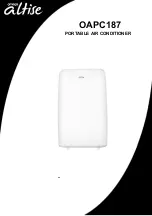
Page 12
4 − Remove the pressure tap valve cores from the
HSXA15 unit’s service valves. Connect an HCFC−22
cylinder with clean refrigerant to the vapor service
valve. Connect the HCFC−22 gauge set to the liquid
line valve and connect a recovery machine with an
empty recovery tank to the gauge set.
5 − Set the recovery machine for liquid recovery and start
the recovery machine. Open the gauge set valves to
allow the recovery machine to pull a vacuum on the ex-
isting system line set and indoor coil.
6 − Invert the cylinder of clean HCFC−22 and open its
valve to allow liquid refrigerant to flow into the system
through the vapor line valve. Allow the refrigerant to
pass from the cylinder and through the line set and the
indoor coil before it enters the recovery machine.
7 − After all of the liquid refrigerant has been recovered,
switch the recovery machine to vapor recovery so that
all of the HCFC−22 vapor is recovered. Allow the re-
covery machine to pull a vacuum on the system.
NOTE − A single system flush should remove all of the
mineral oil from the existing refrigerant lines and in-
door coil. A second flushing may be done (using clean
refrigerant) if insufficient amounts of mineral oil were
removed during the first flush.
Each time the system
is flushed, you must allow the recovery machine
to pull a vacuum on the system at the end of the
procedure.
8 − Close the valve on the inverted HCFC−22 drum and
the gauge set valves. Pump the remaining refrigerant
out of the recovery machine and turn the machine off.
9 − Use nitrogen to break the vacuum on the refrigerant
lines and indoor coil before removing the recovery ma-
chine, gauges and HCFC−22 refrigerant drum. Rein-
stall pressure tap valve cores into HSXA15 service
valves.
10 −Install the provided expansion valve (approved for use
with R410A refrigerant) in the liquid line at the indoor
coil.
Refrigerant Metering Devices
Use HSXA15 units in TXV systems
systems. See the Len-
nox Engineering Handbook for approved TXV match-ups
and application information.
Expansion Valve Systems
Expansion valves equipped with either Chatleff or flare
type fittings are available from Lennox. Refer to the Engi-
neering Handbook for expansion valves for use with specif-
ic match−ups. See figure 11 for installation of the expansion
valve.
If you install a expansion valve with an indoor coil that
includes a fixed orifice, remove the orifice before the
expansion valve is installed.
Metering Device Installation
expansion
valve
o−ring
o−ring
strainer
liquid line
stub
distributor
Figure 11
Manifold Gauge Set
Manifold gauge sets used with systems charged with
R410A refrigerant must be capable of handling the higher
system operating pressures. The gauges should be rated
for use with pressures of 0 − 800 on the high side and a low
side of 30" vacuum to 250 psi with dampened speed to 500
psi. Gauge hoses must be rated for use at up to 800 psi of
pressure with a 4000 psi burst rating.
Service Valves
The liquid line and vapor line service valves (figure 12) and
gauge ports are used for leak testing, evacuating, charging
and checking charge. See table 2 for torque requirements
Each valve is equipped with a service port which has a fac-
tory−installed Schrader valve. A service port cap protects
the Schrader valve from contamination and serves as the
primary leak seal.
Table 2
Torque Requirements
Part
Recommended Torque
Service valve cap
8 ft.− lb.
11 NM
Sheet metal screws
16 in.− lb.
2 NM
Machine screws #10
28 in.− lb.
3 NM
Compressor bolts
90 in.− lb.
10 NM
Gauge port seal cap
8 ft.− lb.
11 NM
To Access Schrader Port:
1 − Remove access panel.
2 − Remove service port cap with an adjustable wrench.
3 − Connect gauge to the service port.
4 − When testing is complete, replace service port cap.
Tighten finger tight, then an additional 1/6 turn.




































